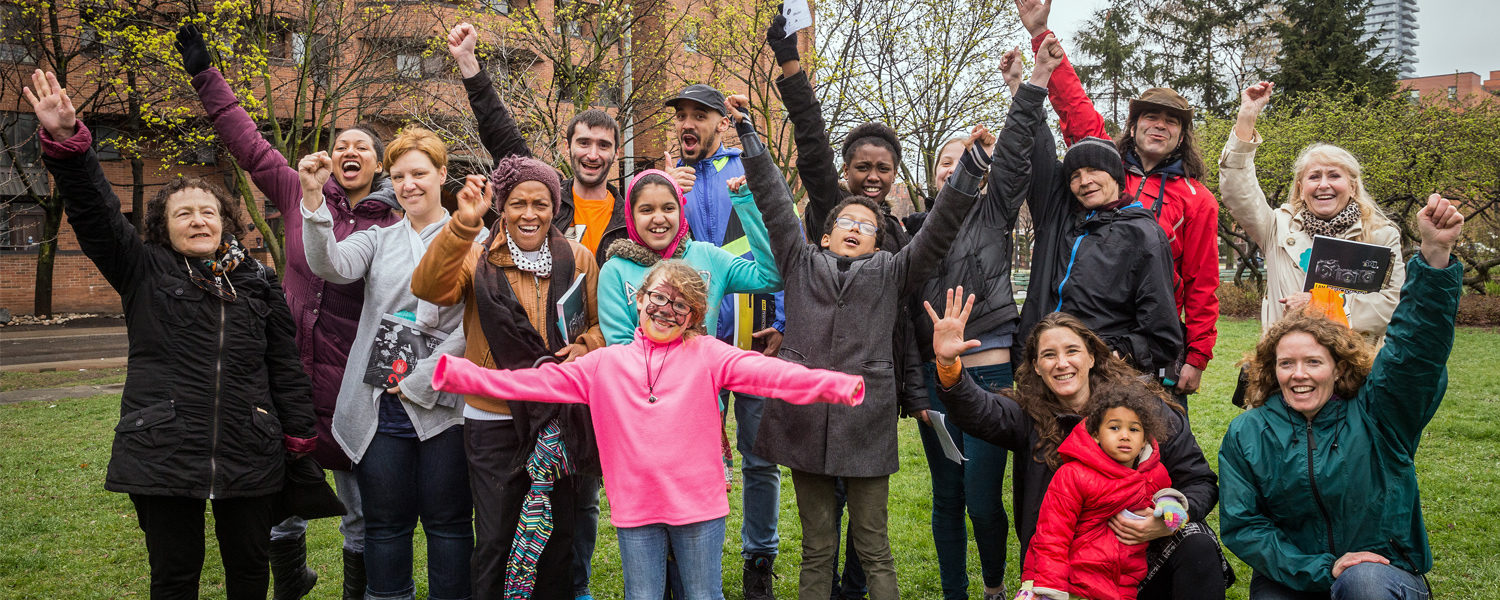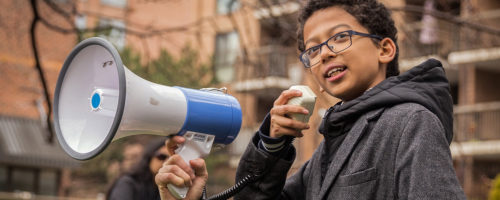A young boy tries to remount a photo box installation that has fallen on the cut grass of Toronto’s David Crombie Park located along The Esplanade in the St. Lawrence neighbourhood. The box won’t stay up. It requires prodding two new holes into the ground for its poles to secure a tight fit, so he decides to notify the supervisor. Before he disappears down the pathway to the brick-layered apartment complex, he points to another installation across the lawn, stating proudly, “I wrote that story.” He smiles, adding that his name is Kai.
Kai is one of 20 writers who participated in the Patchwork Village exhibit, a project that encompassed a collection of written and visual stories created by Esplanadians in celebration of the community’s 40th anniversary. Curated by Isorine Marc, executive and programming director of Jamii, a not-for-profit that produces arts-based, community-engaged projects and events around The Esplanade, the exhibit was one of 20 official public installations in the Scotiabank CONTACT Photography Festival this year.
Lead photographer Charlie Lindsay says he was excited to have his work featured in what’s toted as the world’s largest photography festival for the first time.
“I’ve heard about CONTACT . . . since I first started doing photography, so to have that under my belt and to have this project — especially this project because it was so unique for me,” says Lindsay. “Having [my work in] CONTACT is really cool because it’s such a big platform for photographers.”
A mosaic of faces from different places, the culture is diverse — enough that a chicken and waffle restaurant (traditional American South soul food) can be found run by a couple from the Middle East.
According to Jamii, in the 1970s, the St. Lawrence neighbourhood was the product of an urban reform movement, led by Mayor David Crombie and other like-minded reformers. They had visions to transform an area that was once dominated by industrial land into a municipally planned, socio-economically mixed, inner city residential development.
Forty years later, over 10,000 people call The Esplanade home, relishing in a community feeling they haven’t quite been able to experience elsewhere. A mosaic of faces from different places, the culture is diverse — enough that a chicken and waffle restaurant (traditional American South soul food) can be found run by a couple from the Middle East. Low-rent and subsidized rental accommodations are uniquely juxtaposed with co-ops and condominiums. And at its core is the six-block long David Crombie Park (Crombie Park for short) — with its pedestrian pathways, fountains, playgrounds and basketball courts — which Jamii uses for its programmed activities to encourage people to take ownership of the public space, as Marc says is done in her native France.
Deeply woven in the community’s physical and social fabric, however, are rich stories of discovery, pain and triumph. Forty of them were displayed as part of the exhibit from May 1 to June 27, which started with the photo box installations (three-dimensional photo art displays), styled by artist Jacques Fortier, spread throughout the neighbourhood. All the installations then migrated to Crombie Park to form a circle, fostering the idea of a community connected through the generational stories its residents shared. But these stories would not have been told without the efforts of the writers themselves.

“Like, all of a sudden, [their stories] were just all brought to life.”
This was a group of participants who were also from The Esplanade, who ranged from children as young as nine years old to seniors, who weren’t experienced writers or reporters, and who, for some, English was not their mother tongue. They met with contemporary blues poet and arts educator Anne-Marie Woods, a.k.a. Amani, once a week for three months to learn the interviewing and creative writing skills they needed to write the stories of their subjects. The results were powerful.
Woods recalls an exercise she completed with the writers. She asked them to re-write their stories as if they were telling a children’s tale. It was a transformational moment for her and the group. “I was thinking that way it could kind of bring out some of the language and the colours and just some of the life of the stories of the people they interviewed and that exercise was amazing,” says Woods. “Like, all of a sudden, [their stories] were just all brought to life.”
The writers interviewed residents from all walks of life — community developers, teachers, business owners and everything in between — while videographer Laura Dittmann documented.
One such story is that of Debbie, who has been blind since birth and experiences the world through her sense of touch, intuition and imagination. When she was a child, her father taught her how to waterski because he felt there were no obstacles his daughter could not overcome.
“A big thing is emotion. All the stories — they all had a different type of vibe.”
There is also the story of Glen. By age 30, he had witnessed many of his friends die of AIDS and was kicked out of his Winnipeg apartment for being gay. A friend on his deathbed asked him what he was going to do with his life. Little did he know Glen would become Toronto Centre member of provincial Parliament Glen Murray and Ontario Minister of the Environment & Climate Change, championing gay rights and equality, especially in a current climate of escalating hate crimes against the LGBTQ+ community.
Working in collaboration with the writers, Lindsay drew upon the personalities and backstories of the subjects to capture a more intimate portrait that would complement the story.
“A big thing is emotion. All the stories — they all had a different type of vibe. So there would be some people who have been through really hard times. For instance, there’s someone who was . . . tortured and we had to sort of get that out in the photo a bit, just to show the emotion of that,” Lindsay explains. “There was a teacher who was super energetic and charismatic and getting his energy in that — like that was something that I wanted to make sure we did.”
The final project, which began taking shape in January, was a touching experience for many audience members. “I think the end results really showed the process, which is the process of creativity and a lot of people have complimented the pictures,” says Marc. “At the same time, the pictures work really well with the text and with the vibe of the project, so I think that was good.”
Feature photos (top and middle) taken during the unveiling of the Patchwork Village exhibit. // Photo supplied courtesy of Laura Dittman




Comments are closed.